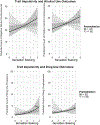Premeditation moderates the relation between sensation seeking and risky substance use among young adults
- PMID: 26415063
- PMCID: PMC10064834
- DOI: 10.1037/adb0000075
Premeditation moderates the relation between sensation seeking and risky substance use among young adults
Abstract
Young adulthood is a peak period for externalizing behaviors such as substance abuse and antisocial conduct. Evidence from developmental neuroscience suggests that externalizing conduct within this time period may be associated with a "developmental asymmetry" characterized by an early peak in sensation seeking combined with a relatively immature impulse control system. Trait measures of impulsivity-sensation seeking and premeditation-are psychological manifestations of these respective systems, and multiple prior studies suggest that high sensation seeking and low premeditation independently confer risk for distinct forms of externalizing behaviors. The goal of the present study was to test this developmental asymmetry hypothesis, examining whether trait premeditation moderates the effect of sensation seeking on substance use and problems, aggression, and rule-breaking behavior. Using a cross-sectional sample of college-enrolled adults (n = 491), we applied zero-inflated modeling strategies to examine the likelihood and level of risky externalizing behaviors. Results indicated that lower premeditation enhanced the effect of higher sensation seeking on higher levels of positive and negative alcohol consequences, more frequent drug use, and more problematic drug use, but was unrelated to individual differences in antisocial behaviors. Our findings indicate that the developmental asymmetry between sensation seeking and a lack of premeditation is a risk factor for individual differences in problematic substance use among young adults, and may be less applicable for antisocial behaviors among high functioning individuals.
(c) 2015 APA, all rights reserved).
Figures

Similar articles
-
Drinking motives as mediators of the impulsivity-substance use relation: pathways for negative urgency, lack of premeditation, and sensation seeking.Addict Behav. 2012 Jul;37(7):848-55. doi: 10.1016/j.addbeh.2012.03.016. Epub 2012 Mar 17. Addict Behav. 2012. PMID: 22472524 Free PMC article.
-
Impulsivity and Problem Drinking in College: Examining the Mediating Role of Sex-Related Alcohol Expectancies and Alcohol Use at Sex.Subst Use Misuse. 2017 Jul 3;52(8):992-1002. doi: 10.1080/10826084.2016.1268629. Epub 2017 Mar 20. Subst Use Misuse. 2017. PMID: 28318348 Free PMC article.
-
Pregaming potentiates risk between UPPS-P impulsivity and day-level drinking behavior: A test of person-environment transactions theory.Exp Clin Psychopharmacol. 2024 Jun;32(3):340-349. doi: 10.1037/pha0000695. Epub 2023 Nov 30. Exp Clin Psychopharmacol. 2024. PMID: 38032611 Free PMC article.
-
Impulsivity Dimensions and Risky Sex Behaviors in an At-Risk Young Adult Sample.Arch Sex Behav. 2018 Feb;47(2):529-536. doi: 10.1007/s10508-017-1054-x. Epub 2017 Sep 7. Arch Sex Behav. 2018. PMID: 28884246 Free PMC article.
-
Personality Traits in Individuals with the Dual Diagnosis of Psychosis and Substance Use Disorders: A Comprehensive Review and Meta-Analysis.J Dual Diagn. 2021 Jan-Mar;17(1):34-51. doi: 10.1080/15504263.2020.1839827. Epub 2021 Jan 6. J Dual Diagn. 2021. PMID: 33404373
Cited by
-
Interpreting Interaction Effects in Generalized Linear Models of Nonlinear Probabilities and Counts.Multivariate Behav Res. 2022 Mar-May;57(2-3):243-263. doi: 10.1080/00273171.2020.1868966. Epub 2021 Feb 1. Multivariate Behav Res. 2022. PMID: 33523708 Free PMC article.
-
Marijuana practices and patterns of use among young adult medical marijuana patients and non-patient marijuana users.Drug Alcohol Depend. 2017 Jan 1;170:181-188. doi: 10.1016/j.drugalcdep.2016.10.025. Epub 2016 Oct 26. Drug Alcohol Depend. 2017. PMID: 27987475 Free PMC article.
-
Evidence for Sex Differences in Depression, Sexual Attitudes, and Impulsivity as Predictors of Breaking Shelter-in-Place Orders During the COVID-19 Pandemic.Arch Sex Behav. 2023 Aug;52(6):2527-2538. doi: 10.1007/s10508-023-02609-3. Epub 2023 May 8. Arch Sex Behav. 2023. PMID: 37154881 Free PMC article.
-
The influence of age on gambling problems worldwide: A systematic review and meta-analysis of risk among younger, middle-aged, and older adults.J Behav Addict. 2024 Sep 13;13(3):702-715. doi: 10.1556/2006.2024.00051. Print 2024 Oct 4. J Behav Addict. 2024. PMID: 39269778 Free PMC article.
-
Mind the gap: A review and recommendations for statistically evaluating Dual Systems models of adolescent risk behavior.Dev Cogn Neurosci. 2019 Oct;39:100681. doi: 10.1016/j.dcn.2019.100681. Epub 2019 Jul 25. Dev Cogn Neurosci. 2019. PMID: 31404858 Free PMC article. Review.
References
-
- Achenbach TM, & Rescorla LA (2003). Manual for the ASEBA adult forms & profiles. Burlington: University of Vermont, Research Center for Children.
-
- Aiken LS, & West SG (1991). Multiple regression: Testing and interpreting interactions (pp. 75–87). Thousand Oaks, CA: Sage Publications.

